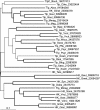An energy taxis transducer promotes root colonization by Azospirillum brasilense
- PMID: 15375141
- PMCID: PMC516605
- DOI: 10.1128/JB.186.19.6595-6604.2004
An energy taxis transducer promotes root colonization by Azospirillum brasilense
Abstract
Motility responses triggered by changes in the electron transport system are collectively known as energy taxis. In Azospirillum brasilense, energy taxis was shown to be the principal form of locomotor control. In the present study, we have identified a novel chemoreceptor-like protein, named Tlp1, which serves as an energy taxis transducer. The Tlp1 protein is predicted to have an N-terminal periplasmic region and a cytoplasmic C-terminal signaling module homologous to those of other chemoreceptors. The predicted periplasmic region of Tlp1 comprises a conserved domain that is found in two types of microbial sensory receptors: chemotaxis transducers and histidine kinases. However, the function of this domain is currently unknown. We characterized the behavior of a tlp1 mutant by a series of spatial and temporal gradient assays. The tlp1 mutant is deficient in (i) chemotaxis to several rapidly oxidizable substrates, (ii) taxis to terminal electron acceptors (oxygen and nitrate), and (iii) redox taxis. Taken together, the data strongly suggest that Tlp1 mediates energy taxis in A. brasilense. Using qualitative and quantitative assays, we have also demonstrated that the tlp1 mutant is impaired in colonization of plant roots. This finding supports the hypothesis that energy taxis and therefore bacterial metabolism might be key factors in determining host specificity in Azospirillum-grass associations.
Figures







Similar articles
-
A PilZ-Containing Chemotaxis Receptor Mediates Oxygen and Wheat Root Sensing in Azospirillum brasilense.Front Microbiol. 2019 Mar 1;10:312. doi: 10.3389/fmicb.2019.00312. eCollection 2019. Front Microbiol. 2019. PMID: 30881352 Free PMC article.
-
Energy taxis is the dominant behavior in Azospirillum brasilense.J Bacteriol. 2000 Nov;182(21):6042-8. doi: 10.1128/JB.182.21.6042-6048.2000. J Bacteriol. 2000. PMID: 11029423 Free PMC article.
-
An Azospirillum brasilense chemoreceptor that mediates nitrate chemotaxis has conditional roles in the colonization of plant roots.Appl Environ Microbiol. 2024 Jun 18;90(6):e0076024. doi: 10.1128/aem.00760-24. Epub 2024 May 22. Appl Environ Microbiol. 2024. PMID: 38775579 Free PMC article.
-
Aerotaxis and other energy-sensing behavior in bacteria.Annu Rev Microbiol. 1999;53:103-28. doi: 10.1146/annurev.micro.53.1.103. Annu Rev Microbiol. 1999. PMID: 10547687 Review.
-
Surface characteristics of Azospirillum brasilense in relation to cell aggregation and attachment to plant roots.Crit Rev Microbiol. 2000;26(2):91-110. doi: 10.1080/10408410091154200. Crit Rev Microbiol. 2000. PMID: 10890352 Review.
Cited by
-
A PilZ-Containing Chemotaxis Receptor Mediates Oxygen and Wheat Root Sensing in Azospirillum brasilense.Front Microbiol. 2019 Mar 1;10:312. doi: 10.3389/fmicb.2019.00312. eCollection 2019. Front Microbiol. 2019. PMID: 30881352 Free PMC article.
-
Chemotaxis signaling systems in model beneficial plant-bacteria associations.Plant Mol Biol. 2016 Apr;90(6):549-59. doi: 10.1007/s11103-016-0432-4. Epub 2016 Jan 21. Plant Mol Biol. 2016. PMID: 26797793 Review.
-
Bacillus subtilis Early Colonization of Arabidopsis thaliana Roots Involves Multiple Chemotaxis Receptors.mBio. 2016 Nov 29;7(6):e01664-16. doi: 10.1128/mBio.01664-16. mBio. 2016. PMID: 27899502 Free PMC article.
-
Chemotaxis is required for virulence and competitive fitness of the bacterial wilt pathogen Ralstonia solanacearum.J Bacteriol. 2006 May;188(10):3697-708. doi: 10.1128/JB.188.10.3697-3708.2006. J Bacteriol. 2006. PMID: 16672623 Free PMC article.
-
Using Light-Activated Enzymes for Modulating Intracellular c-di-GMP Levels in Bacteria.Methods Mol Biol. 2017;1657:169-186. doi: 10.1007/978-1-4939-7240-1_14. Methods Mol Biol. 2017. PMID: 28889294 Free PMC article.
References
-
- Alexandre, G., S. E. Greer-Phillips, and I. B. Zhulin. 2004. Ecological role of energy taxis in microorganisms. FEMS Microbiol. Rev. 28:113-126. - PubMed
-
- Alexandre, G., C. Jacoud, D. Faure, and R. Bally. 1996. Population dynamics of a motile and non-motile Azospirillum lipoferum strain during rice colonization and motility variation in the rhizosphere. FEMS Microbiol. Ecol. 19:271-278.
Publication types
MeSH terms
Substances
Associated data
- Actions
LinkOut - more resources
Full Text Sources
Molecular Biology Databases

